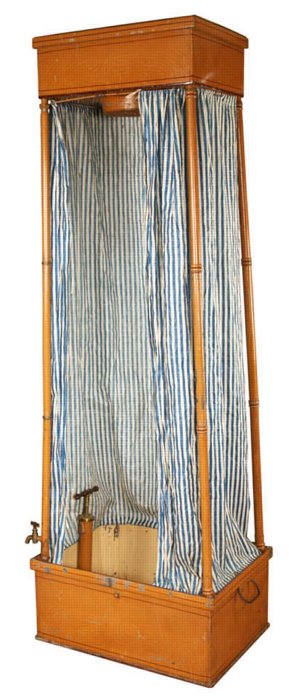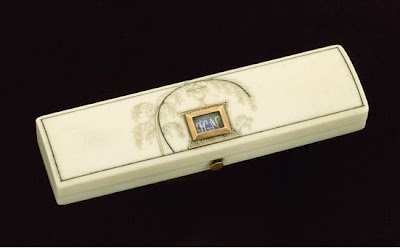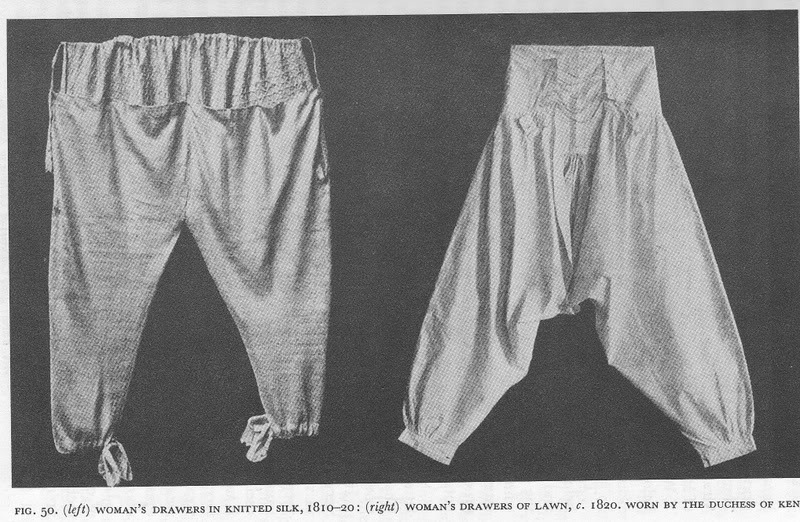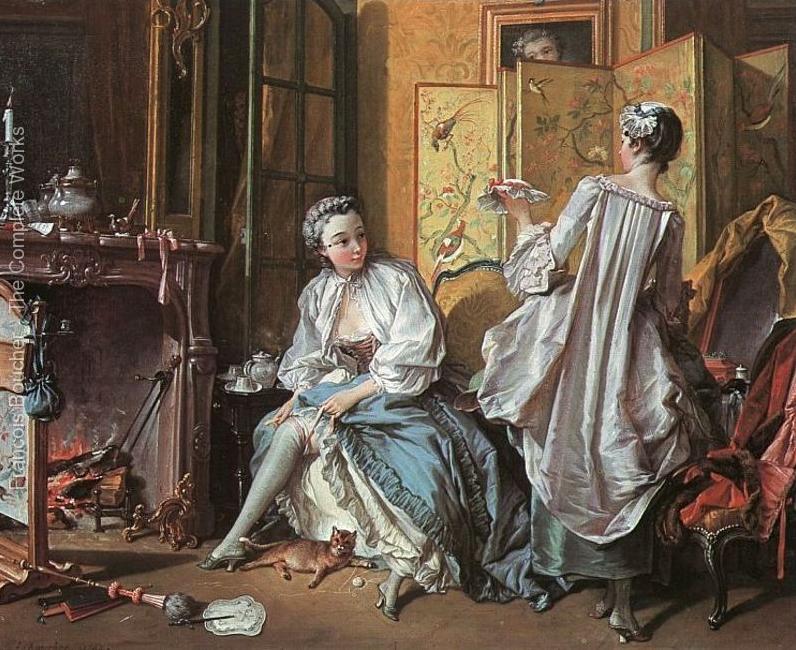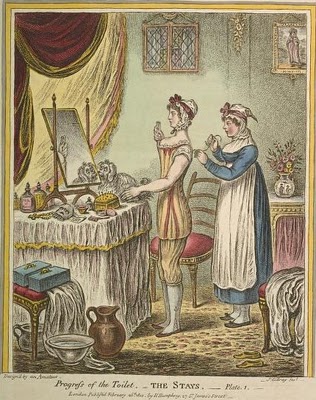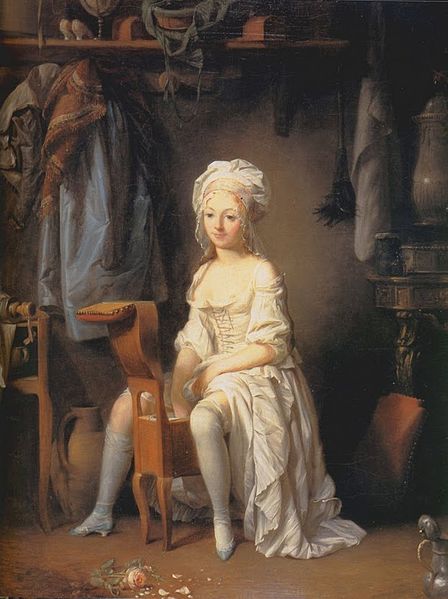After my previous article on Regency Women: Beauty Behind the Scenes, I realized that the things I really want to know more about concerning Jane Austen’s Regency women aren’t (and weren’t) discussed as much as other topics such as beauty regimes.
I wanted to know about bodily functions (where in the world did a lady relieve herself if she was, say, at a ball?), feminine hygiene (what did women do during “that time of the month?”), and pregnancy and birth (why did so many women die as a result of childbirth?).
Finding this information wasn’t as easy as some of the other information I’ve researched over the years. Why? Because some of these topics (such as menstruation) weren’t discussed openly or written about during Jane Austen’s time. Scholarly authors and bloggers even sometimes make the joke, “maybe women didn’t menstruate back then!”
The truth is, Regency women had specific needs, just as women do now, but information about those needs was shared more discreetly. Women passed information, supplies, and advice to one another—from mother to daughter, sister to sister, cousin to cousin, and even friend to friend. Additionally, terms and nicknames were used for certain topics, such as “in that way” (pregnant); “lying-in” or “confinement” (nearing her due date); and “brought to bed” (gave birth). We can imagine that in some families, young women were informed about such topics without much or any discussion; in others, perhaps a bit more instruction was provided.
I can’t help wishing they had not travelled quite so fast, nor made such a long journey of it, for they came all round by London upon account of some business, for you know (nodding significantly and pointing to her daughter) it was wrong in her situation. I wanted her to stay at home and rest this morning, but she would come with us; she longed so much to see you all!”
Sense and Sensibility, Jane Austen (emphasis mine)
Mrs. Palmer laughed, and said it would not do her any harm.
“She expects to be confined in February,” continued Mrs. Jennings.
Lady Middleton could no longer endure such a conversation, and therefore exerted herself to ask Mr. Palmer if there was any news in the paper.
In attempt to shed some light on these topics, the following is an overview of each, along with a few resources that go into greater detail. As always, I heartily encourage our well-read JAW readers to comment with other resources that can help provide more information on these “privy” matters (pun intended).
Bodily Functions
At home, chamber pots were frequently used and kept under the bed, out of sight, and emptied and cleaned by a servant. A privy or outhouse was outside the home, away from the house. Many times, flowers were planted near the outhouse to help cover the odor. For an in-depth history of Regency plumbing, you can read this wonderful article from The Jane Austen Centre on The Development of Regency Plumbing.
But what about when a lady was traveling or at a ball? As some of you may already know, a fully dressed lady could (carefully) relieve herself using a small chamber pot called a bourdaloue (or bourdalou) without soiling her skirts. Her maid would stand nearby to help and/or receive the pot and empty it. (Note: Men were known to relieve themselves behind a screen into a chamber pot in the dining room.) For more on this strangely intriguing topic, you can read Vic’s engaging article, Regency Hygiene: The Bourdaloue.

Feminine hygiene and sanitary items
And what, pray tell, did a lady to do when menstruating? In her article “On ‘Flowers’: A short but frank post on how 18thC women dealt with menstruation,” Lucy Inglis has several interesting tidbits to share: Early sanitary pads were used by women in Georgian England, made from a variety of materials. “Women troubled by particularly heavy periods wrapped a belt or bandage about their hips and wore a baby’s muslin napkin looped over the front and back, with stitched ‘sanitary pads’ lining this loincloth. These pads could be boiled and reused…”
As for tampons, this was surprisingly not unheard of. Early handbooks discuss “‘suppositories’ for the ‘privy place’ made from a smoothed stick, wrapped in absorbent linen rags and securely stitched. A long cord was sewn in. Some disposable; some boiled and reused” (Inglis). For menstrual cramps and other issues, herbal remedies were often used. For more on this topic and others like it, check out Inglis’ book Georgian London: Into the Streets.
Pregnancy and childbirth
During the Regency era, childbirth was still one of the most dangerous threats to a woman’s health and life. Up to 20% of all women died either in childbirth, or immediately following birth, most often due to infection. (Many accounts place the infant mortality rate at about the same level.) The practice of washing hands, disinfecting instruments, and providing clean linens and ventilation in birthing chambers did not become common until about the 1840s, which then lowered the mortality rate from 18% to about 6% (Jane Austen Centre). To read an in-depth discussion of birth, birthing rooms, and advances in obstetrics, read here: “Developements in Childbirth in Regency and Victorian England: Childbirth and Lying-In during the Regency” by Kathleen Charon.
Some of the issues that plagued new mothers and babies were due to limited medical practices and a lack of simple hygiene, but there were other factors at play as well. For instance, instead of having women move, walk, and get a breath fresh air, a “lying-in” or “confinement” period was observed before, during, and even after giving birth.
During the birth, a midwife would likely be in attendance; in some instances, a doctor might come. The birthing room was heated and enclosed so that women would not catch cold; however, the stifling rooms often caused a host of other issues, including an increase in infection. After giving birth, women were kept in bed, often given only weak tea and a liquid diet, instead of hearty, nourishing foods to help her heal and gain strength.
I have just received a note from James to say that Mary was brought to bed last night, at eleven o’clock, of a fine little boy, and that everything is going on very well. My mother had desired to know nothing of it before it should be all over, and we were clever enough to prevent her having any suspicion of it…
Jane Austen’s Letters, Godmersham Park, 17 November 1798.

Indeed, life for women in Jane Austen’s Regency England, even as part of the upper classes, was uncomfortable, difficult, and dangerous. When I think of my own birth, and the births of my two children, by caesarean section, with the help modern medicine, I stand amazed at the bravery of the women who came before me. To say I’m thankful for the miraculous advances in medicine and obstetrics today would be an understatement.
This, I’m sure, is only the tip of the iceberg with these topics. If you have other resources to share, such as books, articles, podcasts, or talks, please include them in the comments! Next month, check back for my upcoming article, Regency Women: Pin Money and Private Expenses.
RACHEL DODGE teaches college English classes, gives talks at libraries, teas, and book clubs, and writes for Jane Austen’s World blog and Jane Austen’s Regency World magazine. She is the bestselling author of The Anne of Green Gables Devotional: A Chapter-By-Chapter Companion for Kindred Spirits and Praying with Jane: 31 Days Through the Prayers of Jane Austen. Her newest book The Little Women Devotional is now available for pre-order and releases December 2021. You can visit Rachel online at www.RachelDodge.com.



